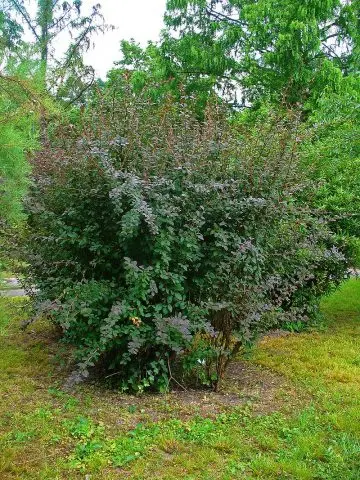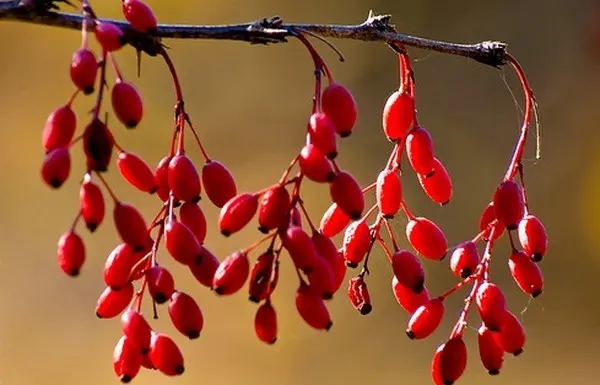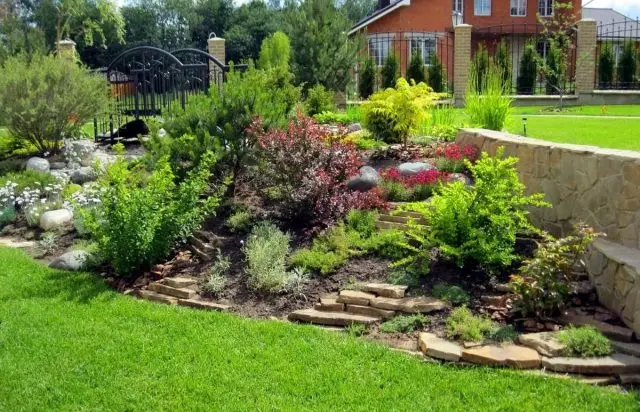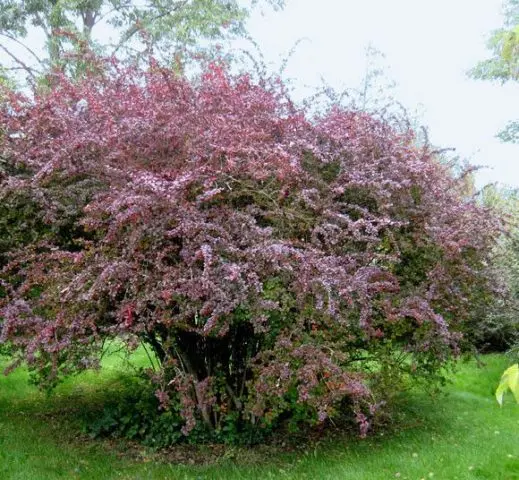Contents
The common barberry is one of the representatives of the shrubs of the Barberry family, which includes about 600 species. This southern plant has long been adapted to life in temperate regions, where it is cultivated as a source of medicinal berries, as well as an ornamental plant used in various types of landscape design.
Description of the common barberry
The plant is native to Southwest Asia. At present, the natural range covers, in addition to the Arabian Peninsula, also Asia Minor, the Caucasus and South-Eastern Europe. The plant in the wild prefers edges, slopes and small lawns; in general, these are areas protected from the wind, but in the sun.
The name of the common barberry in Latin is Berberis vulgaris. This is a fairly tall plant (up to 250 cm), which is a shrub with very strong and lignified rhizomes. The plant is covered on the outside with a light brown bark, the inside of which has a bright yellow color unusual for a plant. The roots of the plant are creeping, consisting of several large rhizomes.
Shoots are upright, practically without slope. On some shoots there is a well-defined ribbing. The color of the shoots is yellowish or purple. Shoots have a kind of “specialization”, depending on the length. Leaves are formed on shortened shoots. On elongated shoots, thorns are formed instead of leaves.
The leaves of the plant are alternate, rather thin, mostly having an elliptical shape. Their length reaches 4 cm, and their width is about 2 times less. Closer to the base, the leaves taper into a wedge. The top of the sheet is predominantly rounded, in rare cases – pointed. The spines have a complex shape – usually they are 3 or 5 separate. Their length reaches 2 cm.
The color of barberry leaves, even within the same species, can vary significantly – from bright green to various shades of yellow or red. Some subspecies can change their color during the season, which is used in landscape design.
A photo of the common barberry is presented below:

How the common barberry blooms
The common barberry shrub blooms in late April or early May, depending on weather conditions: the warmer the weather, the earlier flowering will begin. The flowering period lasts about a month. Pollination is carried out by insects. The plant belongs to monoecious, however, for a larger number of fruits, cross-pollination and the presence of at least 2-3 plants in the garden at a distance of no more than 30 m from each other are recommended.
The flowers of the plant are yellow, small in size (6-10 mm in diameter). Each flower has six sepals and petals. The flowers are collected in inflorescences of the “brush” type. Each brush includes from one and a half to three dozen flowers. The length of the inflorescence is about 60 mm.
The flowers are arranged as follows: at the base there is a nectary, orange in color, a large pistil is surrounded by 6 stamens located on the side opposite to the petals.

The fruits of the plant ripen for a relatively long time – after setting, at least two months pass before ellipsoid-shaped berries appear, which change their color to bright red, in rare cases, purple for another month. The seeds of the plant are short and flattened, up to 7 mm long.

Use in landscape design
Ornamental trees and shrubs of common barberry are widely used in landscape design. You can even say that this plant is used almost everywhere. It is included in the design of the following elements and groups:
- alpine slides or rockeries;
- as separate elements of the landscape;
- as the centerpiece of a group landing;
- for framing lawns or flower beds;
- for the formation of hedges;
- for registration of perimeters of flower beds;
- to create high borders, etc.
It is believed that the rock garden is the most optimal place for planting barberries. Moreover, both plants of medium height (up to 1,5-2 m) and dwarf varieties (no more than 0,5 m in height) are used. In one case, the barberry is the top of the composition, and in the latter case, it is used as a transitional element that softens too much difference in the growth of certain plants.
The use of barberry in rock gardens is also due to its excellent combination with other plants, in particular, with conifers. In addition, a wide palette of leaves allows you to perfectly combine it with other representatives of the fauna. In autumn, most varieties of barberry change their color and can retain leaves for quite a long time, while maintaining the overall decorative effect of the entire composition.

Using barberry as a border plant or hedge, you can be guaranteed to protect the lawn or flower bed from unwanted guests. Dense thickets of this shrub create an almost insurmountable barrier for both two-legged and four-legged visitors to the garden.

A barberry hedge can be either natural or regularly sheared. The plant tolerates pruning well and can be used to make a barrier of almost any shape. The use of such design elements can turn a garden or some corner of it into a secluded place, hidden from prying eyes.
For small gardens, it will be very practical to use the barberry in the form of a single planting as a free-standing plant. Since the variety of forms of a plant bush or its color is very large, such a design will fit perfectly into any design.

A well-grown shrub will look very organic in almost any style of garden design. Small inflorescences, covering the shoots of plants in large numbers, will not leave anyone indifferent. Despite the barberry’s love for sunny areas, its single plantings can also be carried out in partial shade. Usually, common purple barberry with variegated shades of leaves is planted in open areas; bushes with green or dark green foliage are mainly planted in shade or partial shade.
Barberry goes well with various plants, which ensures its use in various flower beds or mixborders. And the change in leaf color depending on the time of year gives an even greater variety of decorative solutions.

So barberry goes well with lilac, jasmine or wisteria. Of the autumn flowers, it gets along well with asters, chrysanthemums or septembers. Combining various plants, taking into account their growth and other features, you can create very interesting compositions in which the emphasis at different times of the year will be riveted to various representatives of the population of the flower bed.
What is made from common barberry
The berries of the common barberry have a sweet taste with a barely noticeable sourness. Mostly various sweets are prepared from them:
- preserves;
- jams;
- jelly;
- jujube.
Also, various juices, syrups and nectars are obtained from barberry berries.
In addition, barberry is included in many recipes of traditional and classical medicine. For medical purposes, not only its berries are used, but also leaves, roots and bark. The main diseases in the treatment of which barberry products can be used:
- liver and kidney disease;
- diseases of the gallbladder;
- various pathologies of the stomach and intestines;
- diseases of the oral cavity;
- eye diseases;
- diseases of the cardiovascular system;
- diseases of the organs of vision;
- scurvy;
- tuberculosis.
In addition, barberry is used as a component for a wide range of homeopathic preparations.
Planting and caring for common barberry
Caring for common barberry is extremely simple and does not require serious skills from the gardener. The main thing is that it should not be allowed to overgrow or thicken. The growth rate of barberry is moderate, so the crown will have to be formed almost every season.
Seedling and planting preparation
Growing barberry is best done in a sunny area, shade or partial shade are a compromise. Nevertheless, the plant will feel good there, however, its growth rate will be somewhat lower.
Barberry prefers light soils with an average degree of moisture. However, it can be grown in any soil. It is desirable to use dry soils, since the plant tolerates drought better than waterlogging.
Rules of landing
Landing is best done in early autumn or late spring. Seedlings must contain at least 4 buds on each shoot. Planting is carried out in such a way that the distance between the bushes is from 50 cm to 1 m.
On poor soils, a complex fertilizer for ornamental garden plants is introduced into the wells, containing the entire necessary set of trace elements: nitrogen, potassium and phosphorus.
Watering and top dressing
Watering is done only as the soil dries. This usually happens 1 time in 15-20 days.
The first top dressing is done in the second year after planting. It consists of nitrogenous fertilizers (urea at a concentration of 0,2% in the amount of 10 liters per bush). In the same season, the bushes are mulched in late autumn with a layer of peat. This procedure is repeated in subsequent years.
Trimming
Pruning consists of sanitary and forming. Sanitation is carried out in early spring. Its technology is standard: dry, diseased and damaged branches are removed. Also, with it, shoots growing “inside” the bush are removed.
Formative pruning is carried out, depending on the chosen role of the plant in landscape design. It is made twice per season, usually in early summer and early autumn. The “format” of pruning and its intensity depend on the chosen form of the shrub and its place in the overall composition.
Preparation for winter
Barberry ordinary is able to endure frosts down to -45 ° C, so it does not need to be prepared for winter. Even young plants tolerate the harshest winters well without additional shelter.
Reproduction
Barberries reproduce in standard ways:
- division of the bush;
- with the help of cuttings;
- layering;
- offspring;
- seeds.
There are no particular preferences, however, it is believed that barberry is preferable to propagate by layering or cuttings.
Diseases and pests
Barberry is quite unpretentious and easily copes with diseases on its own. Powdery mildew will be the only problem a gardener may face. They fight it by repeatedly spraying the plant with a solution of colloidal sulfur until the symptoms disappear.
Of the pests, the barberry aphid should be noted, which, attacking the leaves of the plant, leads to its drying. This parasite is small and difficult to detect, so you should regularly inspect the underside of the leaves. As a means of combating aphids, it is recommended to use a soap solution at a concentration of 0,3%.
Conclusion
The common barberry, due to its decorative properties, is widely used in landscape design of gardens, cottages and household plots. This plant can be used in various combinations with others and tolerates cold climates very well.









